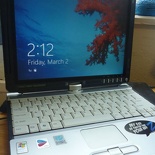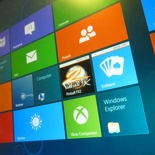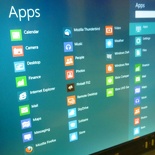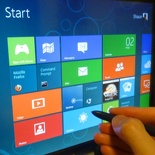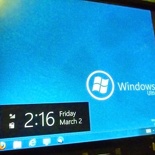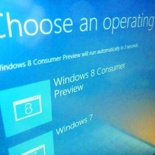When the Metro interface was first announced for Windows 8, I had the humorous impression of it being Windows Phone for PC. We’ve seen the Metro interface already being implemented on the Xbox and the Windows Phone platform, knowing Microsoft’s enthusiasm on this rather unique interface, it will be only a matter of time before it finds it’s way into their flagship product.
Metro for Windows acts as in intermediary gateway for users to launch apps. In Windows, it serves as the new start menu between the desktop and “Apps”, positioning itself as a launching UI, allowing an out-of-the-box style of navigation via window boxes. Gone is the familiar start button on the task bar, invoking “Start” now means hovering your mouse on various “hotspots” on your screen or using the Windows button (which you will intuitively find yourself using more often now). With Metro comes with it’s own set of special shortcut keys allowing you to transition to various App listing via an Aero-like interface of sidebars, charms (window-C) and the start menu (windows button) itself.
Windows 8 still has the speed and capabilities to run on older machines. I had Windows 8 dual booting on a 7-year old single core Centrino-based Tablet PC, which was previously running Windows 7 Ultimate. Windows 8 is still largely based off Windows 7, so they should behave similarly performance-wise. Going with Metro has alway been thought to doubled edged decision for Microsoft, one which will usually make or break an OS, the change here is in-fact more drastic than the one we saw with Windows XP and the transition then to the more stable and “secure” NT file system.
The radical new interface runs like a charm. It’s both fresh, zippy and pleasant to the eye, and will definitely catch the attention of anyone. Microsoft has a strange obsession with buzzwords on their new OS, particularly the over used of the word “Apps” and “Charms” which I find hard to stick as names not representative in any of the elements on the UI. Microsoft claims that Metro is as intuitive to use on a tablet as well as trackpad based laptops, but I beg to differ even with tablet capabilities on my machine. I found the touch and swipe movements not as intuitive as that on Android or even iOS, the OS still retains much of the fixed, segmented tablet input structure we see in the previous version of windows, with weird scrollbars popping out of nowhere and Windows swipe gestures conflicting with the current touch interfaces. But I can attribute that now for the lack of refinement in the alpha release, as well as the lack of touch support drivers for my machine, which will be rectified on future releases.
Moreover, the speeds are excellent. Performance of Windows 8 will be best supplemented by a solid state harddisk (SSD), which has not only allowed me to breathe new life into this old system but prove that Windows 8 isn’t as slow as it was perceived to be. Movement swipes and transitions are fast and smooth and I hardly ever need to invoke high CPU usage in Metro too. Also, having an SSD also allows you to capitalize the extremely rapid boot and shutdown times the new OS is known for. I managed to get a 5s OS boot up after POST and 10 seconds shutdown, with the closing of running Apps on the shutdown phase the only reason for slowdowns. Quantifiable average boot times are roughly 3 times faster than Windows 7 on a similar setup on this early alpha release.
Metro has found a very nice spot between it’s bigger Android and iOS platform brothers, without invoking any design cues of any rivaling operating systems (which we can only see ending under a barrage of infringement claims in court). But I personally find the new interface frustrating to use, especially for power users who know their stuff around Windows well. Metro is simply eye candy which pokes into all your doings, I at times find it more of the hassle having to hover-wait over hotspots to invoke a start menu, or reaching out to the keyboard for the Windows button to get an App list up- tasks previously which can be done with a single click from a mouse in one hand. Also, what’s peculiar is that Windows 8 is trying be both a tablet and full-fledged operating systems in a single package, with many features we won’t need or use on either side. However, it is still good to know that deep down inside of Windows 8 lies pretty much a nearly identical version of Windows 7, if Metro is not to your liking, you can in-fact completely customize the OS to look just like the predecessor, but then there comes the question of even the need to upgrade from Windows 7.
There are still several evident quirks and nagging bugs on the Metro UI at this point of release, as well as the return of the glaring driver issues which we saw with Windows 7. For me, driver issues, especially for my old hardware usually means lots of wasted time writing and re-writing compatible drivers with an occasional forced BSOD. But these problems will be rectified in the next release as well as a more larger and complete driver library in the RTM. Metro is still an on-going development so changes are still planned in the pipeline until at least the beta stage.
But don’t get me wrong, Metro is an ingenious piece of kit. Windows 8 had received a mixed bag of contrasting opinions so far, but what is really most promising is the move from x64 and x86-based platforms to ARM or even Ti-opmap based platforms, where the true ability of Windows 8 can be realized by bringing desktop computing to tablets. The tablet PC of yesterday was clunky, heavy and simply just functions as a PC strapped onto a heavy photo frame. It does not have the instant-on capabilities and suave of today’s modern tablets.
Windows 8 could be Microsoft’s chance at redeeming their failed vision of the tablet PC, despite arguably, Microsoft could had taken the tablet PC further if they were to expand more on the now-defunct Windows Mobile for slate tablets 10 years ago- way before iOS was launched. Who would have thought of that? Maybe the consumer market just wasn’t ready for a tablet device then. Then again, who would even conceive the notion of Nokia and Microsoft teaming up to make phones a decade ago? It was something too-far fetched then.
So will we be seeing Windows 8 on your ARM-based Android phones or even iPhones in the future? That may not be too far fetched now.

